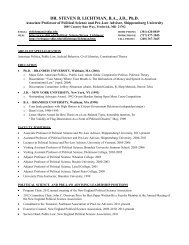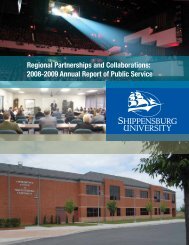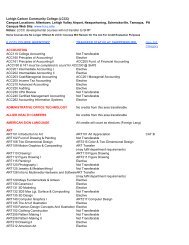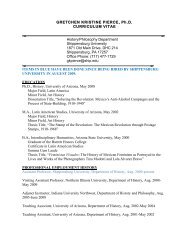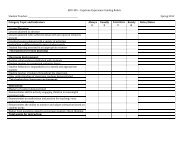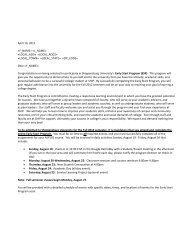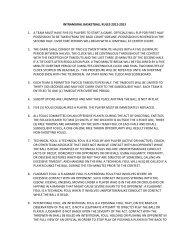Complete Issue - Shippensburg University
Complete Issue - Shippensburg University
Complete Issue - Shippensburg University
- No tags were found...
Create successful ePaper yourself
Turn your PDF publications into a flip-book with our unique Google optimized e-Paper software.
Edward Pitingolo: Competitive Structure of the Global DBO Water Supply Industry 63growth. Its core strategic plan must comprise thefollowing attributes:• Expect and manage for sustainable growth,developing a consistent vision and mission,correlating to applicable models.• Export the national advantage internationally(Porter 2000).• Exploit its role as an MNE (Dunning 1993).• Explore change initiatives.General SummaryBeginning with a rich history in antiquity as in theaqueducts of the Roman Empire, water distributionepitomizes the basic infrastructure requirementfor society’s economic development. Partly theresponsibility of government and partly the undertakingof private enterprise, water supply systems providetangible benefits across a given spectrum. The basicneed for water will not diminish and the continualimplementation of water system capabilities remains onthe horizon.Equally noble with the task of ensuring a watersupply is the history of Veolia Environment. Pioneersin developing water supply system technologies, thefirm evolved into a premier global producer of watersupply systems. Its current operations ensure continuedgrowth in foreign markets. Veolia maintains success inassessing and scanning its competitive environment.The global marketplace for water distributionsystems continues to expand, either as a forerunner tofuture economic development or as simply supplyingthe basic component of life that is water. Varied levelsof water supply systems exist globally between theindustrialized nations and its poorer counterparts.This supports multiple potential for the water supplyDBO under either circumstance, continuing tosupply industrialized nations or developing poorergeographical regions. The emerging economies of Asiapresent substantive opportunity, particularly its Chineseinvestment. As these opportunities evolve, this sectormust adapt with the market place.This industry encounters a mix of applicablestructures for its operations. Water supply DBOsmust exploit their market position to encompass anypotential structure whether a public-private partnershipor true water privatization. Eventually developingproducts encompassing sewage treatment with watersupply in a unitary ecosystem provides benefits to theexisting product mix. This potential model combiningtotal water management better allocates economicresources.Employing models, such as Porter’s five forces thataccesses competitive rivalry and Porter’s diamondmodel accessing the home country’s strengths fosteringa competitive advantage abroad enables strategicplanners a view of the necessary direction required formanaging the firm. Veolia shows considerable foresightby its early investment in China. Its collaborationwith the Chinese warrants exploration for continuedbenefits. Veolia’s national advantage and previousexport of this advantage enables consistent capture ofeconomic benefits from lower international transactioncosts. Any water supply DBO Chinese relationshipfurthers the need for evaluation based upon the politicalambivalence and direct nature of the communistcountry. Successful operations require devisingplans that employ scenarios for any contradictinggovernmental developments. Veolia may export itscompetitive advantages as it discerns translatableconcepts from dealing with the Chinese to otheremergent ventures.The water supply DBO products and services existin a virtuous expanding cycle in both the countriesit operates in and by the nature of its products andservices; their operations convert to extended societalbenefits. The potential exists, particularly with truewater privatization, for exploitation in a given societyspecifically in Third World countries. Convolutingdoctrine and policies may continue the vicious cycle ofdecline encountered in these poor nations; nations thatcan least afford negative implications.This sector’s tool kit in dealing with the globalenvironment in total and individually with its Chineseoperations consists of multiple strategic planningattributes. These attributes comprise goal-seekingscenarios for achieving management’s intentionsand incorporating multiple dynamic paradigms thatrequire continuous improvement. Veolia’s environmentscanning capabilities derive from its home countryadvantage, adding competitive advantages because ofthe favorable home country environment.Change in the water supply system industry remainscontinuous; therefore, management must expect andemploy techniques seeking opportunities for change.Veolia must incorporate its varied history and success,and utilize its history as a springboard for growth andnot an anchor. For example, any DBO must examinenew technology and embrace the model of the totaleco-system water management attribute. This strategicplanning enables forward momentum for this industryand its global operations.REFERENCESAnonymous. 1999. 80 companies will dominate global markets.(1999, November). Water & Environment International.8(63). 13. Retrieved June 13, 2007, from Business SourcePremier database.Anonymous. 2001. French Firms Create Better Ways ofMonitoring and Controlling Drinking Water Quality. WaterEngineering & Management. 148(3)(March): 20. RetrievedJune 13, 2007, from Business Source Premier database.Anonymous. 2004. Global water market. Chemical Engineering.11(5)(May): 19-29. Retrieved June 13, 2007, fromBusiness Source Premier database.



